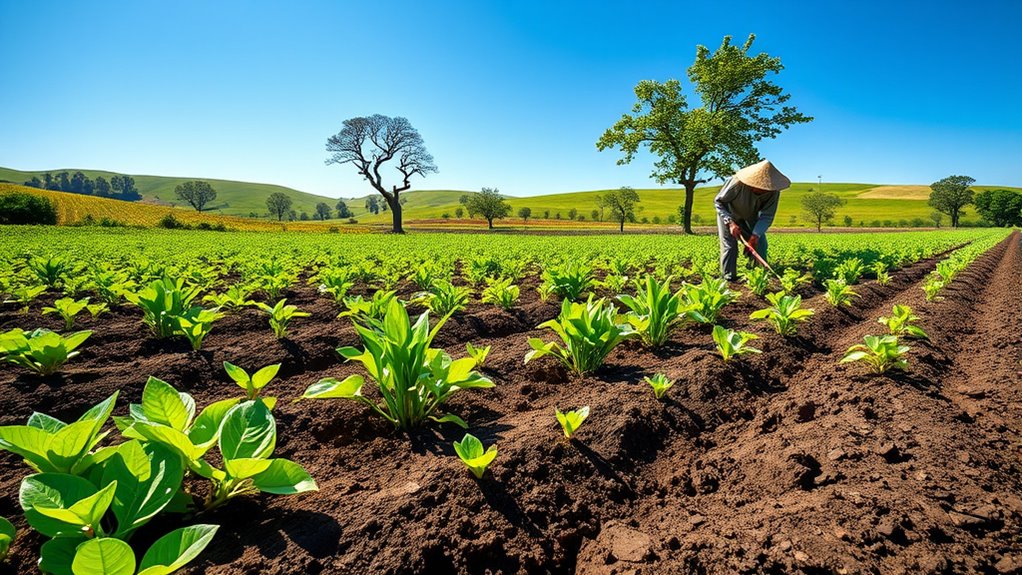Carbon farming turns your soil into a powerful climate hero by naturally capturing and storing carbon through regenerative practices. By adopting crop rotation, planting legumes, and supporting soil microbes, you can boost soil health and reduce greenhouse gases. These methods help sequester carbon effectively while improving farm resilience. If you want to understand how your actions can create a healthier planet, explore more about how soil can be your best climate ally.
Key Takeaways
- Soil acts as a natural carbon sink by storing organic matter and supporting microbial activity that sequesters CO2.
- Implementing regenerative agriculture practices, like crop rotation and cover cropping, enhances soil health and carbon storage.
- Microbial diversity in healthy soil boosts carbon sequestration and overall soil vitality.
- Crop rotation with legumes and deep-rooted plants improves nutrient cycling and increases organic carbon levels.
- Turning agricultural lands into carbon sinks actively reduces greenhouse gases and helps mitigate climate change.

Have you ever wondered how agriculture can help fight climate change? The answer lies beneath your feet, in the soil. Healthy soil is more than just dirt; it’s a crucial tool in capturing carbon and reducing greenhouse gases. By focusing on improving soil health, farmers can turn their fields into carbon sinks, actively removing excess CO2 from the atmosphere. One of the most effective strategies to achieve this is through crop rotation. When you rotate different crops seasonally, you prevent soil depletion, break pest cycles, and build up organic matter that naturally sequesters carbon. This practice not only enhances soil fertility but also boosts its ability to store carbon safely.
When you prioritize soil health, you’re engaging in a cycle of sustainability. Healthy soil contains a rich mix of organic matter, microbes, and nutrients, all of which contribute to better water retention and crop resilience. As you adopt crop rotation, you diversify the plant life, which fosters a thriving ecosystem beneath the surface. This diversity encourages beneficial microbes that help lock carbon into the soil, reducing the amount released into the atmosphere. Furthermore, crop rotation minimizes the need for chemical inputs, such as synthetic fertilizers and pesticides, which can harm soil microbes and decrease soil’s carbon storage capacity. Recognizing the importance of soil microbes has led to greater emphasis on soil microbiome health as part of sustainable farming practices. Incorporating practices that support microbial diversity can significantly enhance soil carbon sequestration. Additionally, employing regenerative agriculture techniques can further amplify these benefits by restoring degraded lands and promoting soil vitality.
You’ll find that integrating crop rotation into your farming routine is straightforward and highly effective. For example, planting nitrogen-fixing legumes one season adds nutrients back into the soil naturally, improving crop yields and soil vitality. Following this with a deep-rooted crop like a cover crop or a grain helps break up soil compaction and promotes organic matter buildup. As you cycle through these different crops, you’re not only improving soil health but also creating a resilient agricultural system that can adapt to changing climate conditions.
Frequently Asked Questions
How Does Carbon Farming Impact Local Biodiversity?
You might wonder how carbon farming affects local biodiversity. By implementing practices like native species planting and habitat restoration, you help support diverse ecosystems. These efforts promote healthier soil and provide refuge for local wildlife. As a result, biodiversity increases, benefiting both the environment and your community. You play a crucial role in maintaining ecological balance while also contributing to climate change mitigation through sustainable land management.
Are There Economic Incentives for Farmers Adopting Carbon Farming?
Think of market incentives and policy support as your guiding stars. Yes, there are economic incentives for farmers adopting carbon farming, like grants, tax credits, and carbon offset payments. These incentives act as a financial wind at your back, encouraging sustainable practices. Governments and markets increasingly recognize benefits, making adoption more attractive. By leveraging these supports, you can boost your farm’s resilience and profitability while helping combat climate change.
What Are the Long-Term Effects of Soil Carbon Sequestration?
You’ll find that soil carbon sequestration boosts soil health by improving fertility and structure, which leads to better crop yields. Over the long term, it enhances climate resilience by increasing the soil’s ability to retain water and withstand extreme weather events. This process also helps reduce greenhouse gases in the atmosphere, supporting a healthier environment. Ultimately, maintaining healthy soil through sequestration offers enduring benefits for both your farm and the planet.
Can Carbon Farming Be Integrated With Traditional Farming Practices?
You can definitely integrate carbon farming with traditional practices. By focusing on improving soil health through methods like crop rotation and cover cropping, you enhance organic matter and sequester more carbon. This approach complements conventional farming, boosts yields, and promotes sustainability. Combining these strategies allows you to maintain productivity while contributing to climate change mitigation, making your farming more resilient and environmentally friendly in the long run.
How Accessible Is Carbon Farming Technology for Small-Scale Farmers?
Imagine a small farm adopting cover cropping to boost soil health. For you, access to carbon farming technology can be hindered by cost barriers, making it hard to start. Additionally, limited knowledge access might leave you uncertain about best practices. While some programs offer subsidies or training, overall, technology remains less accessible for small-scale farmers, emphasizing the need for tailored support to make carbon farming more inclusive.
Conclusion
By embracing carbon farming, you’re turning soil into a powerful tool against climate change, much like harnessing the energy of a secret alchemist. You can help restore our planet’s health, making the earth a better place for future generations—think of it as planting the seeds for a green revolution. So, roll up your sleeves and get involved; together, you and the soil can write a new chapter in the story of climate action.





